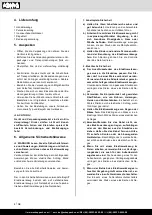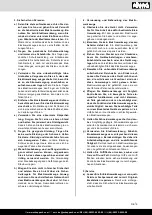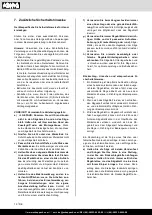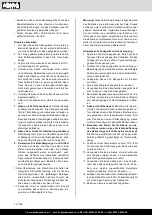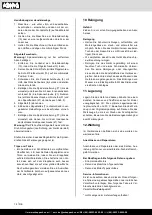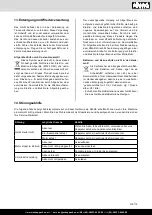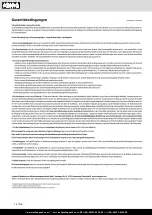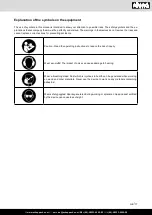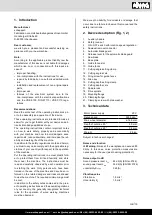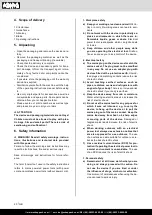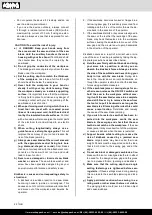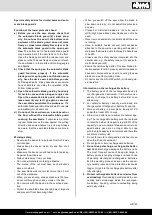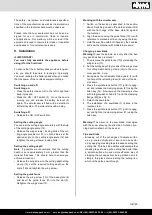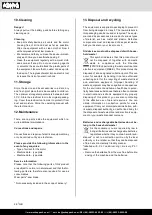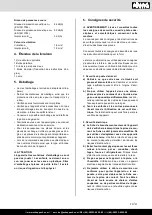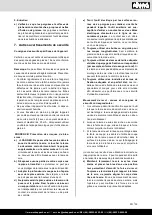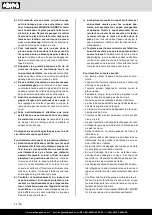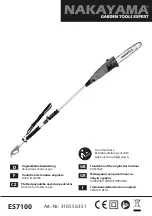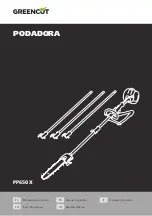
www.scheppach.com /
+(49)-08223-4002-99 /
+(49)-08223-4002-58
22 |
GB
2.
If the sawblade becomes hooked or trapped in a
narrowing saw gap, it is suddenly prevented from
rotating and the force of the motor throws the de-
vice back in the direction of the operator.
3.
If the sawblade distorts or becomes misaligned in
the saw cut, the teeth at the rear edge of the saw-
blade may hook themselves into the workpiece
surface causing the sawblade to move out of the
saw gap and the circular saw to jump backwards
in the direction of the operator.
Kickback occurs as a result of incorrect use or mis
-
use of the saw. It can be prevented by taking the ap
-
propriate precautions as described below.
a) Hold the saw firmly with both hands and bring
your arms into a position in which you can
absorb the kickback forces. Always stand to
the side of the saw bla
d
e and never bring your
body in line with the saw blade.
During kick-
back, the circular saw can jump backwards, al
-
though the operator is able to control the kickback
forces using suitable measures.
b) If the saw blade jams or sawing stops for an
-
other reason, release the ON / OFF switch and
hold the saw in the workpiece without mov
-
ing it until the saw blade comes to a complete
stand still. Never try to remove the saw from
the tool or to pull it backwards as long as the
saw blade is still moving otherwise this could
cause a recoil action.
Determine and remedy
the cause of the saw blade jamming.
c) If you wish to restart a saw that has been in
-
serted into the workpiece, centre the saw
blade in the saw gap and check that the saw
teeth do not catch on the workpiece.
If the saw
blade jams, it may move itself out of the workpiece
or cause a kickback when the saw is restarted.
d) Support boards whilst cutting to reduce the
risk of kickback caused by a jammed saw
blade.
Large boards may bend under their own
weight. Panels must be supported on both sides,
that is both close to the sawing gap and at the
edge.
e) Do not use blunt or damaged saw blades.
Saw
blades with blunt or misaligned teeth are in effect
too wide for the designed saw gap and this gives
rise to increased friction, jamming and kickback.
f) Make sure that the cutting depth and angle
setting fastenings are tightened before saw
-
ing starts.
If th
ese settings move during sawing,
this can lead to the saw blade jamming and kick
-
back.
g) Apply particular caution when sawing in ex
-
isting walls or other areas that are not visible.
The plunging blade could jam in a hidden object
and cause kickback.
• Do not operate the device if it is damp and do not
use it in a damp environment.
•
If you use the device outdoors, always connect
it through a residual current device (RCD) with a
maximum trip current of 30 mA. If using an exten
-
sion lead, always use one that is approved for out
-
door use.
CAUTION! To avoid the risk of injury:
a)
m
DANGER: Keep your hands away from
the area around the saw and clear of the saw
blade. Hold the auxiliary handle or the motor
housing with your free hand.
If both hands hold
the circular saw, they cannot be injured by the
saw blade.
b) Do not grip the underside of the workpiece.
The blade guard cannot protect you from the saw
blade under the workpiece.
c) Set the cutting depth to match the thickness
of the workpiece.
Less than a full tooth height
should be visible below the workpiece.
d) Never hold the workpiece in your hand or
steady it with your leg whilst sawing. Keep
the workpiece steady on a stable supporting
surface.
It is important to see that the workpiece
is firmly held in place to minimise any danger of
it making contact with your body, jamming of the
saw blade or loss of control.
e) When performing work during which the elec
-
trical tool can meet with concealed power
lines or its own power cord, hold the electrical
tool by the insulated handle surfaces.
Contact
with a live cable will also energise the metal parts
of the electrical tool and will lead to an electric
shock.
f) When cutting longitudinally always use a
guide fence or a straight edge guide.
This will
improve the accuracy of your cut and reduce the
risk of the blade jamm
ing.
g) Always use a saw blade of the correct size and
with the appropriate central fixing hole bore
(e.g. diamond-shaped or round).
Saw blades
that do not correspond with the attachment com-
ponents on the saw will not run true and could
lead to loss of control.
h) Never use a damaged or incorrect saw blade
washer or screw.
The saw blade washer and
screw have been s
pecially designed to give your
saw optimum performance and safety in use.
Kickback - causes and corresponding safety in
-
structions:
1. A kickback is a sudden reaction to a saw blade
becoming hooked, jammed or misaligned. This
causes an out of control circular saw to raise itself
and move out of the workpiece and towards the
operator.
Содержание 5901812900
Страница 2: ...2 www scheppach com service scheppach com 49 08223 4002 99 49 08223 4002 58 1 6 9 1 2 3 4 5 7 8 11 12 ...
Страница 4: ...4 www scheppach com service scheppach com 49 08223 4002 99 49 08223 4002 58 ...
Страница 16: ... www scheppach com service scheppach com 49 08223 4002 99 49 08223 4002 58 16 DE ...
Страница 113: ... www scheppach com service scheppach com 49 08223 4002 99 49 08223 4002 58 113 ...
Страница 114: ...114 www scheppach com service scheppach com 49 08223 4002 99 49 08223 4002 58 ...

